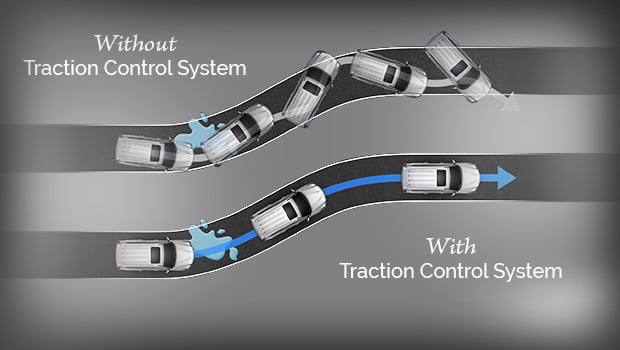In this edition of the Automobile Technology section, we shall discuss some of the most common and useful active safety technologies present in a lot of modern vehicles. But before we begin, we would like to tell you that our aim with this content is to bring the technicalities of complex modern technologies in vehicles to you in a simple and easy-to-understand language so that you get to learn more about your beloved automobiles. So make sure to check out Car Blog India for all the latest news and scoops from the world of automobiles, along with the technical articles from automobile engineering.
Also read: Camshafts and Valves – Working and Classification!

The topic of today entails the growing sophisticated active safety technologies filtering down to almost cars of every segment and price point these days. These safety features include ABS, EBD, ESP, Brake Assist and Traction Control, to name a few. Now, all these features have trickled down to even budget cars now a day because of two reasons primarily. The first reason is the laws that require modern vehicles to have some of these features as standard otherwise the OEMs can not sell these cars. THat has even caused the customers to be mindful of such features and demand them across the segments. The other reason being, more and more involvement of electronics in modern vehicles. There are multiple components from electronics communication to make sure that the cars’ ECU (Electronic Control Unit). As a result, the responses from the electronics make sure that the passengers stay safe during difficult situations where the driver doesn’t get enough time to respond.
Also read: What is EGR (Exhaust Gas Recirculation) – Working, Principle & Advantages!
ABS – Anti-Lock Braking System
Generally, when the driver suddenly applies brakes to a moving car, there is a high probability that the wheels will get stuck due to the sudden brake force and slide on the road. In fact, this will cause the car to be out of the driver’s call even if the driver manages to act quickly. This happens because the momentum of the velocity of the car carries it and the wheels are not able to covert that into the rotational movement because of brakes. The ABS, as the name suggests, prevents the wheels from getting locked and instead provide intermittent braking force to allow for the wheels to spin a little. This enhances the braking efficiency of the car substantially and also allows the driver to steer the vehicle away from the obstacle under heavy braking. This is a relevant feature to have in any car.
Also read: Uses of a 48V hybrid system – Regenerative Braking, Turbo Boost, Fuel Economy & More!
EBD – Electronic Brake-Force Distribution
As the name suggests, this feature ensures the distribution of brake force to the wheels according to the road conditions and requirements of the driver. There are speed sensors to detect the velocity of the wheels and car. The data is fed into the ECU which compares the two values constantly. When it senses that there has been slippage due to the high speed of the wheels than that of the car, it sends the command to provide a little brake force to the wheel which is slipping. This feature takes into account which wheel requires more brake force and provides it to that wheel independently.
Also read: What is Air Suspension – What are Stiff and Soft Springs?
Brake Assist
The Brake Assist is another important feature aimed at making sure that the brakes are applied in case of an emergency if the driver is unable to respond quickly enough. This happens a lot that in case of sudden braking the drive is not able to press the brake pedal fully. With Brake Assist, the electronics sense the speed and force with which the driver pressed on the brake pedal and apply additional pressure on the pedal for full braking. If the brake pedal is released slightly, the pressure on the brake pedal due to the hydraulic assist will also decrease.
Also read: What are Intercoolers – Types and Functions!
ESP – Electronic Stability Program
As mentioned before, modern cars use a ton of electronic equipment for all sorts of functions in a car. The ESP is used primarily for the handling of the car around the corners. This includes features like Roll-Over Mitigation and Cornering Stability Control. The ESP detects that the weight of the car has shifted to the side wheels during a corner and provides braking or acceleration to that wheel so that the car comes out of the corner as quickly as possible. Similarly, while braking, the weight of the car is transferred to the front wheels and the braking force will be more useful on those wheels. That is how ESP functions.
Also read: What is Engine Braking – How does Cooling System work?
Traction Control
The Traction Control is close monitoring of the situation that each of the wheels is in. This is one of the most important features in 4×4 off-roading vehicles. It becomes of utmost importance that the ECU knows where each of the wheels is when it is off the road. Sometimes, one or more wheels might be on water, ice, sand, rocks or in the air. Depending upon the data by the wheel and car speed sensors, the Traction Control system recognizes that it is irrelevant to provide either the braking force or torque to the wheel which does not have any traction or is slipping. Therefore, the torque or the braking force is redistributed to the wheels with traction so that the vehicle can come out of any road condition.
Also read: What is Engine Knock – What are its consequences and how to prevent it?
Hill-Hold Assist
This function is especially useful while driving in the hills or on the slopes. When the driver stops the vehicle on a slope, the electronics make sure that the brake force is applied to the wheels for 2-3 seconds more even after the brake pedal is released. This gives the driver enough time to lift the foot from the brake and press the accelerator pedal without letting the car slide backward.
Also read: Variable Valve Timings and Lift – How does it affect Efficiency and Fuel Economy?
All these functions have, without a doubt, enhanced the safety aspects of all modern vehicles and have contributed immensely in avoiding or at least reducing the dangerous effects of accidents. With the governments becoming more and more strict about the safety features in a car, even more safety features are likely to become standardized in times to come.
Also read: What are Catalytic Converters – How do they reduce emissions?
Image Source – Gomechanic


